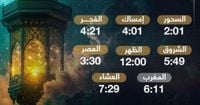As the holy month of Ramadan progresses, many Muslims around the world are preparing for the upcoming observances, including the timing of Suhoor and Fajr prayers on March 28, 2025, which corresponds to the 28th of Ramadan in the year 1446 AH. According to calculations by the astronomical institute, the Suhoor is set for 2:01 AM, Imsak at 4:01 AM, and Fajr at 4:21 AM. This year, Ramadan began on March 1, 2025, and will last for 29 days, concluding on March 29, 2025.
The fasting duration on the shortest day of Ramadan is approximately 13 hours and 20 minutes, while the longest day will see fasting extend for 14 hours and 12 minutes. Ramadan is significant in Islam, marking the ninth month of the lunar calendar and being one of the Five Pillars of Islam, making fasting during this month obligatory for all Muslims.
As Ramadan draws to a close, discussions about the sighting of the crescent moon for Eid al-Fitr have begun. The topic has sparked considerable debate among astronomers and the general public regarding the visibility of the moon on the 29th of Ramadan. While some astronomers assert that the crescent will be visible, others believe it will not be seen, leading to a divergence of opinions.
The International Astronomical Center has clarified that the differences in opinion stem from varying official stances on announcing the start of lunar months. They emphasized that while astronomers provide scientific insights on the crescent moon's visibility, the responsibility for declaring Eid al-Fitr lies with official authorities.
Astrophysicist Badr Al-Omaira, a member of the Arab Union for Astronomy and Space Sciences, predicts that Eid al-Fitr will take place on March 31, 2025, based on astronomical data suggesting Ramadan may last a full 30 days. He noted that the moon's age at sunset would be 4 hours and 56 minutes, which is typically insufficient for sighting the crescent.
Supporting Al-Omaira's view, Dr. Ali Abdul Karim Al-Taani, an astrophysics professor in Jordan, reiterated that the crescent moon would likely not be visible, reinforcing the expectation that March 31 will be the first day of Eid al-Fitr.
In Saudi Arabia, astronomer Khalid Al-Zaqaq indicated that astronomical calculations confirm March 29 will be the last day of Ramadan, with Eid celebrations expected to commence on March 30, provided the weather conditions are favorable for moon sighting.
In Egypt, the Scientific Research Academy has suggested the possibility of sighting the crescent on March 29, which would imply that Sunday, March 30, could be the last day of Ramadan and Monday, March 31, the first day of Eid al-Fitr.
Most countries will conduct moon sighting efforts on Saturday, but the International Astronomical Center has stated that astronomical calculations indicate the crescent will likely not be visible that day, regardless of the observation methods employed, including the naked eye, telescopes, or astrophotography techniques. In some areas of North America, visibility may be possible through telescopes, but it will still be challenging.
The Dar Al-Ifta in Egypt is set to announce the date for Eid al-Fitr on Saturday evening, providing clarity to the faithful as they prepare for the holiday.
As the month of Ramadan comes to a close, the anticipation for Eid al-Fitr grows, with many looking forward to the celebrations that follow the month of fasting and reflection. The varying predictions and discussions surrounding the sighting of the crescent moon reflect the rich traditions and practices that accompany this significant time in the Islamic calendar.





